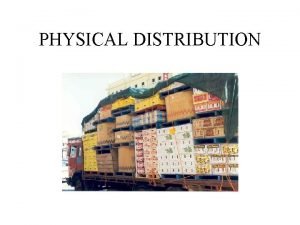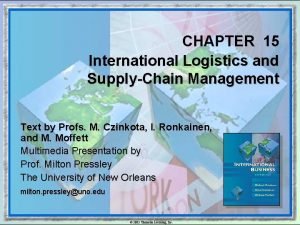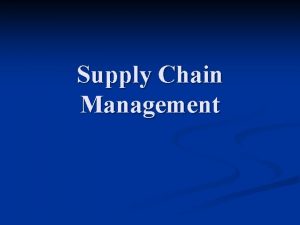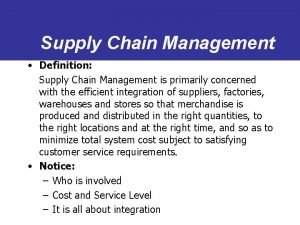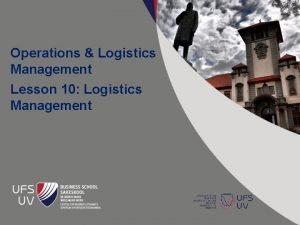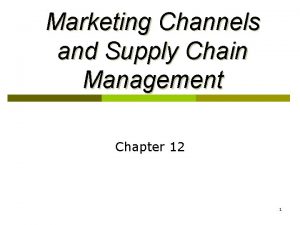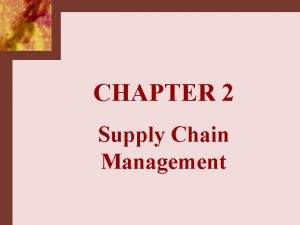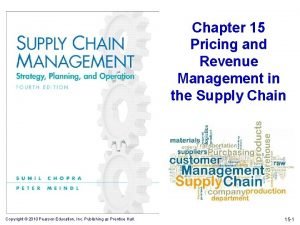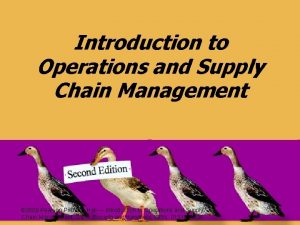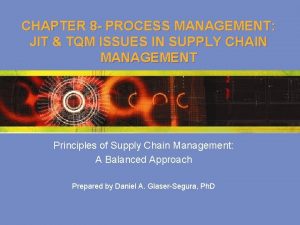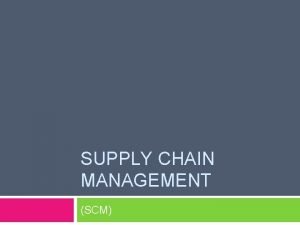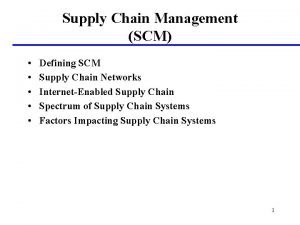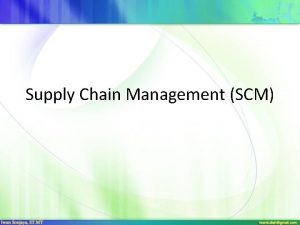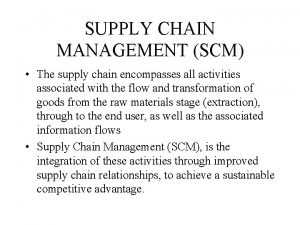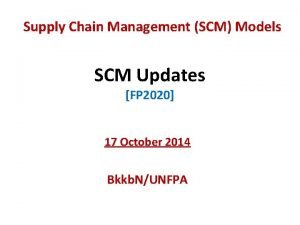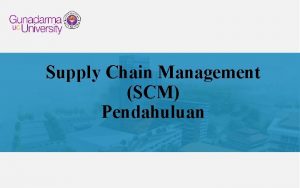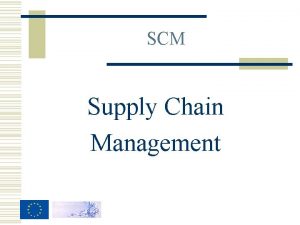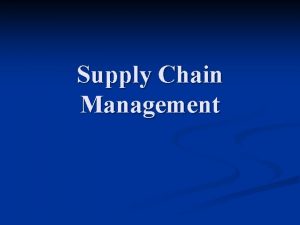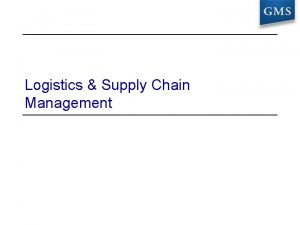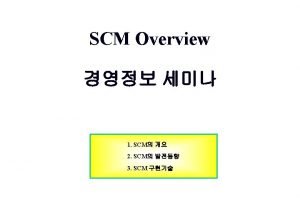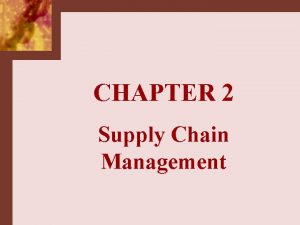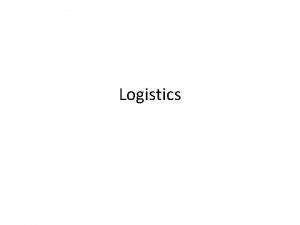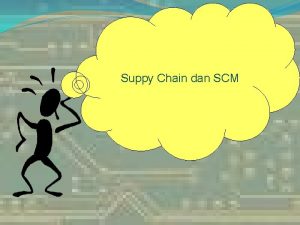Supply Chain Management SCM and Logistics Management LM





















- Slides: 21

Supply Chain Management (SCM) and Logistics Management (LM) are terms often used interchangeably. Discuss. Presented by: Animesh Verma 074003

Brief over view �In 1986 the council of logistics management (CLM), the leading edge professional organization with a current member ship of over 13, 000 defined logistics management as: “The process of planning, implementing, and controlling the efficient, cost-effective flow and storage of goods, services, and related information, from point of origin to point of consumption, for the purpose of conforming to customer requirements. ” �Components of an Integrated Logistics System �Physical Supply: links suppliers to operations process �Internal Operations: manages in-process material flow �Physical Distribution: links operations process to customers

Entry of the “SCM” �From some of the statements it appears that SCM is logistics taken across inter organizational boundaries �A philosophy that describes how organizations should manage their supply chains to achieve strategic advantage �The objective is to synchronize requirements of the final customer with the flow of materials and information along the supply chain. The goal is to eliminate variability and reach a balance between high customer service and low cost

Why the Confusion? �Confusion over the terms supply chain and logistics management has grown over the last decade. �Research would indicate that today the two terns are often used interchangeably, while others feel strongly that there are distinct differences. �The combination of these viewpoints has led to the nebulous grey area where the global transport industry, among others, often finds itself today.

SCM and LM Together Forever �The bottom line is: terms supply chain and logistics management are inextricably intertwined. �While different enough to be recognized as individual terms or processes, the two are so tightly interwoven that they should not be considered separately. �Logistics and Supply Chain functions can and do frequently overlap. �So what are those “different enough” and those “intertwined threads” ?

Viewpoints over SCM and LM �Logistics has a narrower focus on activities involving product distribution and the strategic coordination of flows between marketing and production. �In the case of the global transport industry this would translate into the relationship between transportation and distribution. �While focus of supply chain, on the other hand, additionally encompasses �manufacturing, �purchasing and �Procurement �which by their very nature enhance the focus by including third party suppliers, manufacturers and retailers.

Is this sufficient? ? �Even with these differences it is clear that logistics areas often cut across supply chain functions and vice versa. �But do really VICE VERSA? ? ? �To get into a more clear image of this complex interconnection, definitions of SCM and LM might clear the in depth interconnection.

Defining Supply Chain Management �Complexity and structure of supply chains vary depending on the industry and the organization’s size, �In a nutshell it can be said that supply chain management encompasses the entire process from raw materials to the final customer. �Effective SCM involves oversight and management of suppliers, buyers, vendors, customers, and any others on whom the organization depends on to deliver a product or service.

Still defining SCM �As consumer expectations around service speed and quality, cost, and choice continue to rise, an organization will compete to try and meet consumer demand. �Successful SCM organizes the process to make this happen in a way that also keeps costs low while turning a profit. �Competitive pressures are intense in the global transport world, and SCM has had to keep up. Technology has evolved to expedite communications as well the flow of information. �On board computers and GPS systems for vessels and vehicles, and electronic transmissions for orders and shipping information are just two examples of technologies that have raised the competitive bar and impacted SCM.

Three Levels of SCM Decision Making �SCM processes and technology work to ensure the supply chain is operating efficiently at the lowest cost with optimum customer satisfaction. �To this end, decisions are made at three distinct levels: 1. Strategic: At the strategic level, organizations focus on high level decisions that impact the entire organization. Decisions often revolve around manufacturing site size and/or location, supplier partnerships, sales markets, or the products or services to be manufactured or delivered.

SCM level contd… � Once we are through with strategy the upcoming levels are: 2. Tactical: Tactical level decision making focuses on measures to generate cost benefits like adopting best practices, or creating a purchasing strategy with selected suppliers. 3. Operational: Decisions at this level are made on a daily basis and impact how products/services move through the supply chain. Examples include production schedule changes or warehouse product movement.

Defining Logistics Management �Logistics Management can be defined in plain speak as the movement of products from beginning to end, and encompasses the activities involved along the way. �This includes the planning, implementing and control of the flow (both forward and backward) and storage of goods, services, and related information between the point of origin and the point of consumption to meet customer requirements. �Logistics management begins with the creation of strategies to maintain the most cost effective service levels. �As supply chains continue to change and evolve with regards to specific product lines to impact service levels, customer and market segments, so do the logistics strategies.

Three Levels of LM Decision Making �To develop a successful logistics management strategy decisions must be made on three distinct levels: 1. Strategic: Any successful strategy requires a review of how logistics management contributes to the organization’s high level SCM objectives. 2. Structural: The logistics strategy should examine the structural issues of the logistics organization, such as the optimum number of warehouses and distribution centers, or what products should be produced at a specific manufacturing plant. 3. Implementation: When deciding how to implement logistics management strategies company-wide, plans for an information system, new policy and procedure implementations, and a change management plan must be considered.

SCM Vs. Logistics is the management of the flow of physical materials. In the context of marketing channels, physical distribution and logistics have traditionally been used interchangeably, with the understanding that only finished goods are part of distribution and the proper concern of a marketing channel manager. Logistics has metamorphosed into the concept of Supply Chain Management (SCM), which in turn has come to implicate every element of the Value-Added Chain. Going backward, or upstream, this means channel logistics encompasses not only inventories of finished goods but also work in process (WIP) and raw materials. This, and many other ideas about Indeed, SCM at its fullest goes back not only to the factory floor channel logistics, has changed but also to the suppliers of the radically since the 1980 s. suppliers of the suppliers.

Supply Chain for Milk Products

The Case for SCM �If one studies the term Supply Chain Management from a historical perspective, it would appear SCM has become the more commonly used term, particularly with new and old industry associations alike including or changing their name to include the words “supply chain. ” �To add fuel to the fire that SCM is the brighter star to that of logistics, Ken Ackerman, a noted logistics writer, has gone as far as to question the relationship between the growing popularity of supply chain concepts and logistics. He challenged the differences between the two and even questioned if it was time for the former (supply chain management) to replace the latter (logistics). �Companies increasingly rely on SCM as a key competitive weapon. Impressive results, including dramatic reductions in cycle time and accelerated cash flows, have been noted as a result of effective supply chain management.

The Case for Logistics �Many global transport organization activities reside under the logistics management umbrella, including warehousing, inventory management, private (i. e. , inhouse truck fleets) and purchased transportation such as air, water, highway or rail. �Logistics Management is an increasingly important part of competitive positioning from the perspective of the global transport industry. To stay competitive, exporters must make the right amount of product and services available in the right place at the right time.

What we require LM or SCM? ? ? �Organizations Require Both Logistics and SCM to Succeed �Logistics management is concerned with the movement of goods and services from suppler to consumer. SCM shares this concern, but additionally is responsible for the flow of information and funds from supplier to consumer. �Perhaps this is why many in the industry believe that as long as there is a matrix-type relationship between the two, it should be up to the individual organization to decide what emphasis works best to meet its needs.

The Importance of Logistics in Channels Logistics and Supply Chain Management Inventory Management in Marketing Channels Inventory Holding Costs Supply Chain Management Efficient Consumer Response Physical Efficiency versus Market Responsiveness Changes in Merchandising Reducing Inventory Pseudo Inventory Reduction Real Inventory Reduction Category Management Critical Supply Chain Elements Fulfilment and Transportation Documentation 19

The Verdict… �The verdict is clear. �Given common concerns between the two, as well as the clear overlaps seen time and time again as logistics and SCM cross paths, it should be expected that SCM and logistics will both remain intrinsically intertwined and essential to organization success. �So, analyse your need and problem and give preference to two �But still for final success use BOTH!

Questions? ? ?
 Functional components of e-crm
Functional components of e-crm Mmog self assessment form
Mmog self assessment form Component of physical distribution
Component of physical distribution Global logistics and supply chain strategy
Global logistics and supply chain strategy Value chain and supply chain difference
Value chain and supply chain difference International logistics and supply chain outsourcing
International logistics and supply chain outsourcing Supply chain strategic planning
Supply chain strategic planning Matching supply with demand
Matching supply with demand Contemporary issues in supply chain management ppt
Contemporary issues in supply chain management ppt Food chain food chain food chain
Food chain food chain food chain Correct sequence in supply chain
Correct sequence in supply chain Supply chain management explanation
Supply chain management explanation Logistics management introduction
Logistics management introduction Vertical system
Vertical system Marketing channels and supply chain management
Marketing channels and supply chain management Cscmp definition of supply chain management
Cscmp definition of supply chain management Role of pricing and revenue management in a supply chain
Role of pricing and revenue management in a supply chain Pricing and revenue management in a supply chain
Pricing and revenue management in a supply chain Supply chain management and marketing channels
Supply chain management and marketing channels Introduction to operations and supply chain management
Introduction to operations and supply chain management What is process management in tqm
What is process management in tqm Vertical
Vertical


